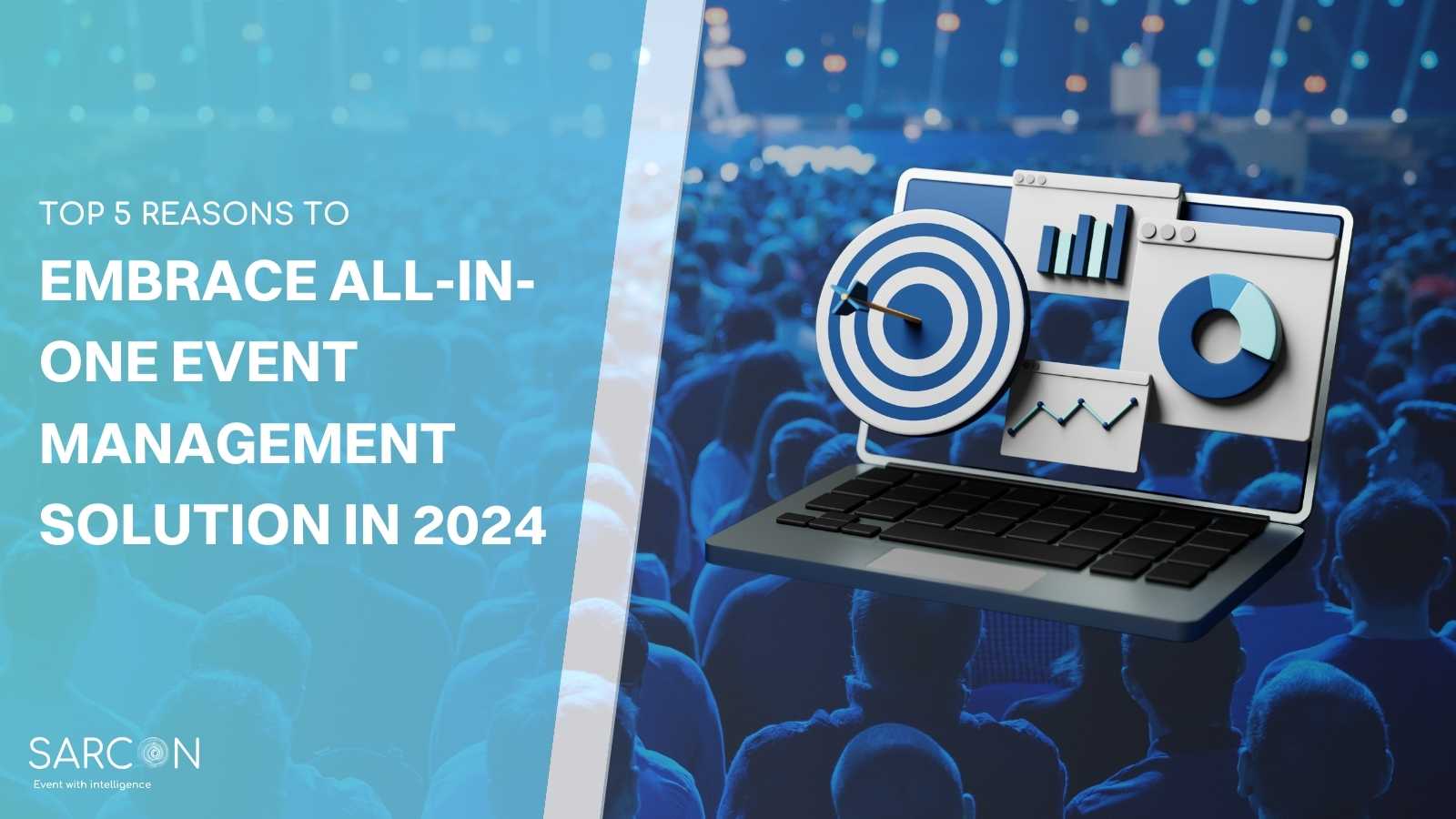Event sponsorship has long been the elephant in the room, a challenge that event planners have struggled to overcome. But it’s time to change that. With events being a top investment for businesses and a proven channel for driving outcomes, securing sponsorships has never been more critical. The good news? We’ve got you covered.
Picture this – the weight of planning and executing a successful event lifted off your shoulders, the roar of excitement from the crowd, and your brand front and centre. That’s what event sponsorship can bring to the table. The challenge has been finding the right sponsors to partner with, negotiating the best deal, and maximising the return on investment. But, with the help of this guide, you’ll become the master of event sponsorship, learning everything you need to know to attract the right sponsors and take your events to new heights.
But before we dive in, let’s start with the basics.
What is event sponsorship?
Simply put, event sponsorship is a form of marketing in which a business or organisation provides financial or in-kind support to an event in exchange for various rights and benefits. This can include everything from naming rights and signage to product placements and promotional opportunities.
The host receives crucial financial support, while the sponsor gets to connect with potential customers in a fun and dynamic setting. So whether you’re hosting an in-person, hybrid, or virtual event, finding event sponsors is a great way to boost your event’s ROI and enhance the overall experience for attendees. But, to attract top-tier sponsors, it’s important to offer them real value in return.
Why is event sponsorship Important?
Event sponsorship is the bees’ knees of marketing. It’s a way to grab the attention of your target audience and engage with them in a meaningful way. Think about it; a well-executed event sponsorship allows you to put your brand front and centre and create an experience that people will talk about for weeks, months, or even years to come!
There’s just something about events that bring people together and create a sense of community. Whether it’s a concert, a trade show, or a charity walk, events are a melting pot of diverse personalities and interests.
And let’s not forget the exposure you’ll receive from event sponsorship. With the right marketing strategy in place, your brand will be seen by thousands of people, including potential customers, media outlets, and influencers. This can lead to increased brand recognition and a boost in sales, all while building a positive reputation in the eyes of your target audience. So, in conclusion, event sponsorship is the cat’s meow of marketing. It allows you to connect with your target audience, increase brand exposure, and create a memorable experience that people will talk about for years to come.
The benefits of event sponsorship
Now that you know what event sponsorship is, let’s talk about why it’s so powerful. Event sponsorship offers a range of benefits for businesses and organisations, including the ability to:
- Reach new audiences: Events are a great way to connect with potential customers or clients who may not be familiar with your business.
- Build brand awareness: Sponsorship allows you to showcase your brand in front of a captive audience, increasing the visibility and recognition of your business.
- Boosted Budget: With the support of a generous event sponsor, you can rest easy knowing that your event budget will receive a much-needed boost, allowing you to create a high-quality, memorable experience for your attendees.
- Valuable Resources: Event sponsors can offer a variety of resources, including money, food, technology, or even keynote speakers, making it easier to bring your event vision to life.
- Establish thought leadership: By sponsoring industry events or conferences, you can position yourself as a thought leader and expert in your field.
- Lead Generation Opportunities: Sponsors can attract larger crowds to your event, resulting in increased revenue potential and a plethora of new leads to follow up on.
In addition to these benefits, event sponsorship also offers a level of flexibility and customisation that other marketing channels may not. Now that you know the benefits of event sponsorship, let’s move on to the types of event sponsorship.
Types of event sponsorship
Sponsorships are like the secret sauce to a successful event. And, just like a good recipe, there are different ingredients to choose from. Four main types to be exact: financial, in-kind, media, and influencer.
1. Financial sponsorship: Think of it as an investment in your event. Companies pour in funds to make your event a success and in return, they get some well-deserved exposure. It’s a win-win, like a friendly game of tennis. Bonus tip: Create tiered packages to offer companies more or less benefits in exchange for their level of funding.
2. In-kind sponsorships: In-kind sponsorships are a more hands-on approach. These are the unsung heroes of the sponsorship world. They provide services, experiences, or goods to make your event even better. Think: yummy food, swanky venues, sweet prizes, and oh-so-cool merchandise.
3.Media sponsorships: Media event sponsorship is a modern twist on the traditional model. With everyone’s eyes glued to their screens, it’s important to have a strong online presence. This type of sponsorship lets you create ads and marketing tailored to your target audience on social media or through email. Perfect for smaller companies looking to make a big impact.
4.influencer sponsorships: Influencers have a huge presence on social media and a loyal following. Partnering with them can take your event and your company to new heights and leave a lasting impression on your audience. It’s like having a megaphone to shout your message to the world.
Setting sponsorship goals and objectives
- Determining your target audience and desired outcomes: Before you start looking for sponsors, take some time to define your goals and target audience. What are you hoping to achieve with your event, and who is your target audience? Having a clear understanding of your goals and target audience will help you find the right sponsorship that aligns with your objectives. This could include reaching new customers, strengthening relationships with existing customers, building brand awareness, generating leads, or any other business or marketing goals.
- Identifying key performance indicators (KPIs) to measure success: To determine whether your sponsorship is successful, it’s important to establish KPIs that will help you measure progress towards your goals. These could include metrics such as brand awareness, website traffic, social media engagement, lead generation, and sales.
- Factor in your sponsor’s budget : One of the most important factors to consider is your sponsor’s budget. It’s essential to know how much your sponsor is willing to spend and what they expect in return. You need to find a balance between what they want and what you need to make the partnership work. Secondly, consider is the type of sponsorship package that you are offering. A mix of tiered sponsorship models can be an excellent way to provide different levels of visibility and benefits. These packages can help you to reach different target audiences and cater to different budgets.
Finding the right event sponsors
- Identify potential sponsors: Once you have a clear understanding of your goals and target audience, start identifying potential sponsors that match your event. You can start by looking at companies that have a history of sponsoring similar events or those that have a strong interest in your event’s industry or subject matter.
- Research and reach out: Once you have a list of potential sponsors, research each one to see if they would be a good fit for your event. Look at their past sponsorships, marketing strategy, and values to see if they align with your event. Then reach out to them, either through email or through a personal introduction, to express your interest in having them sponsor your event.
Negotiating the sponsorship deal
- Determining the value of the sponsorship to your business: Before you begin negotiations, it’s important to determine the value of the sponsorship to your business. This includes considering the size and reach of the event, the value of the rights and benefits being offered, and the potential return on investment (ROI). This will help you determine the level of sponsorship that is feasible and appropriate for your business.
- Identifying the rights and benefits you want as a sponsor: Once you have an idea of the value of the sponsorship to your business, the next step is to identify the rights and benefits that are most important to your business. These could include branding and promotional opportunities, access to event attendees, VIP experiences, and other perks.
- Crafting a sponsorship proposal and contract: With your goals and desired rights and benefits in place, it’s time to craft a sponsorship proposal and contract. This should include a clear outline of the terms of the sponsorship, including the rights and benefits being offered, the duration of the sponsorship, and any other details that are relevant to the agreement.
Activating sponsorship
- Creating a sponsorship activation plan: Once you have secured a sponsorship deal, the next step is to create a plan for activating your sponsorship. This should include a timeline of promotional and branding activities, as well as details on how you will leverage the rights and benefits you have negotiated.
- Identifying opportunities for branding and promotional activities: There are many opportunities for branding and promotional activities within an event sponsorship. These could include signage, product placements, on-site promotions, experiential marketing, content marketing, and influencer marketing.
- Utilising social media and other marketing channels to maximise exposure: In addition to on-site activities, be sure to leverage social media and other marketing channels to amplify the reach and impact of your sponsorship. This could include promoting the event on your social media channels, creating sponsored posts or ads targeting the event’s audience, and leveraging influencer marketing to reach new audiences.
Measuring the success of your sponsorship
- Gathering data and analysing performance against your KPIs: To determine whether your sponsorship was successful, it’s important to gather data and analyse performance against your KPIs. This could include metrics such as brand awareness, website traffic, social media engagement, lead generation, and sales.
- Evaluating the return on investment (ROI) of your sponsorship: In addition to analysing performance against your KPIs, it’s important to evaluate the ROI of your sponsorship. This will help you determine whether the sponsorship was a worthwhile investment and identify areas for improvement or optimisation.
- Identifying areas for improvement and optimisation: After evaluating the ROI of your sponsorship, identify any areas for improvement or optimisation. This could include adjusting your activation plan, negotiating different rights and benefits for future sponsorships, or adjusting your budget for future sponsorship investments.
Conclusion
In conclusion, event sponsorship is a valuable investment that can help take your business or organisation to the next level. By understanding the key components of a successful sponsorship strategy, you can ensure that your investment pays off in terms of increased visibility, engagement, and leads. So, what are you waiting for? Get started on your event sponsorship journey today and take advantage of the opportunities it presents for your business.



